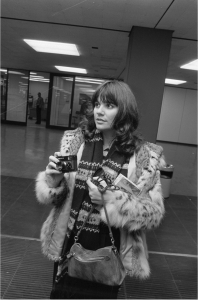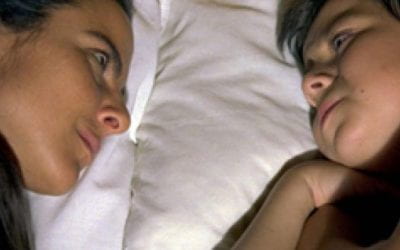Spanish is the Language You Sing In: A Review of Canciones de Mi Padre

“File:Zangeres Linda Ronstadt op Schiphol, Bestanddeelnr 928-8975.jpg” by Rob Bogaerts / Anefo is marked with CC0 1.0
With the help of Spotify’s Discover Weekly, a friend’s recommendation, or some other source I can’t recall, I was introduced to the music of the Stone Poneys early in high school. Though the songs reappeared on playlist after playlist for years, I only learned the name of the woman on the cover — Linda Ronstadt — when watching the documentary Laurel Canyon earlier this year. Directed by Alison Ellwood, the film dives into the lush musical landscape of 1960s and 70s Laurel Canyon and reveals a bounty of overlap and collaboration between artists as influential Joni Mitchell, Crosby, Stills, Nash, and Young, the Mamas and the Papas, Jackson Browne, the Eagles, and countless others who found their musical footing in the hills of Laurel Canyon.
There, too, was Linda Ronstadt. In 1964, she moved from her home in Tucson, AZ to Los Angeles to pursue singing professionally at eighteen years old. The choice to move West towards music was a popular one at the time, and one which didn’t yield results for many. Linda, however, quickly established herself as a serious force on the emergent Folk Rock scene. Only a few months after moving to LA, Linda joined the band the Stone Poneys and began earning industry attention. By 1966, the group had been signed to Capitol Records. By 1968, the Stone Poneys had released three albums. Their single “Different Drum” reached number thirteen on the Billboard Hot 100 charts and remains a beloved and memorable track by the band.
In spite of the Stone Poneys’ burgeoning success, Linda sought to establish herself as an independent singer and released her first solo album in 1969. In the years that followed, she would do just that, launching herself from the position of ‘girl on the album cover’ to which I, and likely many others, had relegated her. Throughout the 1970s, Ronstadt soared in popularity and acclaim, making and breaking records with her exceptional success. For example, Ronstadt made history as the first woman to have three consecutive platinum albums and eventually earned eight consecutive platinum albums. By 1978, she had become the “highest paid woman in rock,” after her combined personal earnings and record sales for the year reached $72 million — roughly $264 million in today’s terms. Ronstadt’s pioneering role as what some have called the first true female rock star was not without its gender-based challenges, however. For one, Ronstadt experienced repeated difficulties assembling a backing band that didn’t feel inferior working for a female lead instead of a male lead. She also struggled as the industry professionals around her pushed an image that Linda felt didn’t align with her authentic self. After multiple photoshoots which left Ronstadt more exposed and sexualized than she felt comfortable with, only to appear on covers as prolific as Rolling Stone and Time, Ronstadt explained in a 1977 interview that, “ I wouldn’t choose to show a picture like that to anybody who didn’t know me personally, because only friends could get the other sides of me in balance.” These experiences led her to reconsider her career as an arena rock performer; starting in the 1980s, Ronstadt lended her musical prowess to an ever-growing range of styles and found more control in the artistic process.
Among ventures into operetta, three albums of standards from The Great American Songbook, and a hit collaboration with legends Dolly Parton and Emmylou Harris on the beloved country album Trio, Ronstadt also released a successful Spanish language album titled Canciones de mi Padre.

“Linda Ronstadt 1979 Champaign” by kevin dooley is licensed under CC BY 2.0
Ronstadt’s great-grandfather Freidrich Ronstadt immigrated to Mexico — then the undefined ‘Southwest’ in the 1840s from Hanover, Germany and married a Mexican citizen. Three generations later, Linda would grow up hearing traditional Mexican songs around the house that impacted her in her formative years. “I didn’t speak very good Spanish as a child, so I thought Spanish was the language you sang in and English was the language you spoke. To me, Spanish was always a musical language,” she recalled. When she assembled the music of her childhood into an album concept, Ronstadt faced resistance from her label as they worried about a Spanish language album’s commercial prospects. However, she found an opportunity to overcome the label’s fears when her father introduced her to the artists Mariachi Vargas and Lola Beltran at a Tucson mariachi conference. When they asked Ronstadt to perform with them the following year, the commercial viability of a Spanish language album became unquestionable. “On the opening night, when I walked out onstage, the place was packed. All three generations showed up—grandmothers, mothers and fathers, and kids—and that thrilled me. They knew how to give a grito at the right moment,” Ronstadt said. In producing Canciones de mi Padre, Ronstadt invested considerable time in sharpening her Spanish pronunciation as she wasn’t fluent in Spanish. She worked alongside influential Mexican composer Ruben Fuentes as her musical arranger. By the album’s release in 1987, her painstaking work proved well worth it. Canciones de mi Padre would go on to become the biggest selling non-English language album in American record history.
Selling successful records never proved too difficult for Ronstadt in any of her eras. What did prove difficult, however, was retaining autonomy over her art and her persona in the male-dominated industry. Canciones de mi Padre appears, then, as not only a beautiful and impressively successful album, but as evidence of Ronstadt’s remarkable perseverance and clarity of vision. As she performed the songs in full Mexican regalia and in the lower end of her powerful vocal range, Ronstadt commanded both the music and the room. While she had complained that the arena tours of the 1970s forged a disconnect between singer and audience, performing Canciones de mi Padre to old and new fans alike allowed Linda to hold her personal heritage in common with Mexican listeners and share that heritage with audiences unfamiliar with Mexican music.
I learned about Linda Ronstadt for the first time in the documentary Laurel Canyon even though I’d heard her voice for years before. When I took the time to explore her career post-Laurel Canyon, Ronstadt’s Mexican heritage and hugely successful Spanish language music came as news to me. It seemed as though the most remembered and invoked segments of her career were those which fit neatly into a cultural milieu. After all, Ronstadt remains best known for her years in the Laurel Canyon scene (and her subsequent arena rock era) and her work on Trio. Looking beyond her musical eras, many people might be acquainted with Ronstadt largely by an awareness of high profile relationships she had. This, to me, flattens the brilliance of Ronstadt’s approach to art and celebrity. She was never content to remain in an artistic environment that had grown stale or restrictive and she fought to present herself and her work on her own terms. A pure love of singing and songs themselves propelled Ronstadt through one of the most varied, technically impressive, and authentic careers in recent memory. It is a disservice to her, then, and to other artists who record both English and Spanish language music, to remember her career within the very boundaries she fought to break.
Margaret Tilley is a rising junior at Barnard College.
Related Articles
A ReView of La Misma Luna
With teary eyes, I finish watching Patricia Riggin’s 2007 film La Misma Luna one more time, a testimony of the unconditional love between a mother and son. Carlitos Reyes, a 9-year-old boy, who lives in Mexico with his grandmother.
Student ReViews: Selena: The Latina in All of Us
We all anxiously awaited the end of 2020, a year that refused to give us a break. Netflix must’ve sensed this despair, and on December 4, “Selena: The Series” was released.
Student ReViews: Monumental Callao is a Step Forward for Peru’s Most Crime-Ridden Area
The taxi ride to Monumental Callao is a gallery visit in itself. Murals, graffiti, 19th-century pastel-colored houses and street carts called ambulantes sell fruits, various fried concoctions and even ceviche in a plastic bag. It’s a colorful reminder that often, underprivileged areas are the most culturally rich.




